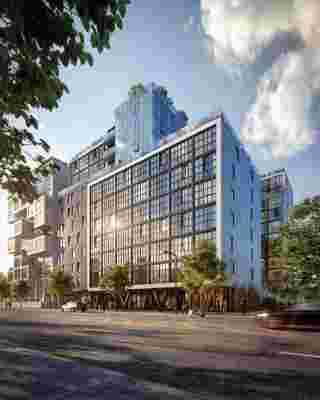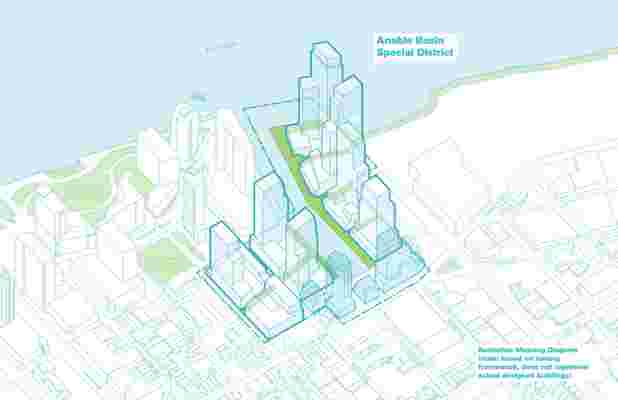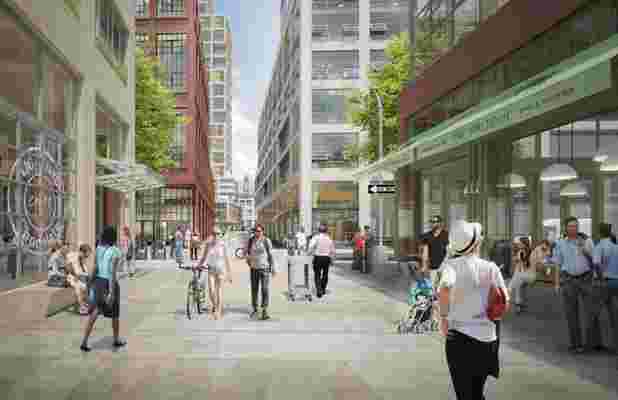In November 2017, long before Amazon zeroed in on locations for its two new headquarters, Long Island City–based plastics manufacturer Plaxall laid out plans to redevelop a strip of waterfront called Anable Basin. The company envisioned the 20-acre site—which runs along the East River and is zoned for light manufacturing—as a mixed-use district that would include housing, commercial space, artists’ studios, a public school, and green space open to the public.
Even before then, though, the surrounding area had started to boom. Warehouses and strip clubs were being torn down to accommodate high-rise luxury apartment buildings and restaurants. Nearly 60,000 people already live in LIC, and the population is expected to explode in the next two years. Companies operating there including JetBlue, Ralph Lauren, and Uber.

Galerie—an 11-story, 182 condominium building—that will open in the spring.
“We’d been looking [for property] since 2012,” says Dvir Cohen Hoshen, founder and managing partner of Adam America, the real-estate development firm behind the Galerie, an 11-story, 182 condominium building across from MoMA PS 1 in Long Island City. Hoshen saw an opportunity to bring Manhattan-style amenities—a swimming pool, a roof deck, a rotating exhibition space—to the Queens neighborhood. “That wasn’t around in Long Island City then,” he says. Next door, 2222 Jackson also offers sleek, state-of-the-art residences. Both were designed by high-end architecture firm ODA New York.
Just 15 minutes from Midtown, Long Island City has eight subway lines, 12 bus routes, and two commuter ferry terminals, and it is close to Kennedy and La Guardia airports. And at roughly $1,300 per square foot, luxury condos there are a good value compared with those in Manhattan. Rents fall along a similar scale.
“[Amazon] discovered what we discovered three years ago,” says Hoshen, who will deliver Galerie’s first space in March 2019.

An aerial plan of the forthcoming Anable Basin Special District.
Prior to the Amazon announcement, about 50 units at Galerie had sold; a mere week later, 20 additional sales were pending. But as the haves seep in (Amazon salaries will average $150,000), longtime locals are at risk of being forced out. This and many other criticisms of the Amazon deal have, of course, already been sounded, and not entirely without reason. Fear of gentrification, lack of affordable housing, potentially one-sided tax credits , and infrastructure woes abound. A taxpayer-funded Amazon helipad has been a particular sticking point for some; an already beleaguered subway system worries others.
In addition to New York City’s $180 million investment in infrastructure updates to Anable Basin—where Amazon will eventually be located—New York State will give out $1.525 billion in tax credits to the tech giant. For its part, Amazon promises to bring 25,000 new jobs to the borough by 2029 and invest more than $3.6 billion over 15 years. The company has also agreed, according to a spokesperson for City Hall, to build according to the already established LIC Waterfront Design Guidelines , which stipulate that development must reflect the “industrial and creative character” of the area, offer open green spaces to the public, and use resiliency strategies. Amazon will also create an employment incubator, a public school, and a 3.5-acre waterfront esplanade, and establish a fund to support local infrastructure. City and state officials predict a nine-to-one return on investment as a result.

A pedestrian-friendly retail and hospitality zone in Anable Basin, which must reflect the “industrial and creative character” of the area.
Of course, promising to replicate vernacular details and build a park is entirely different from ensuring the displacement of people and culture. Key to the neighborhood’s success will be maintaining the rich diversity that already exists there. No doubt that’s easier said than done, but as high-earners and new businesses flood into the region, it should remain a guiding principle. Long Island City has the opportunity to show the country—and perhaps the world—how to build a successful cultural and economic melting pot. The challenges are certainly complex, but even if Amazon were never to move in, the revolution here would already be underway.
RELATED: How the U.S. Midterm Elections Will Affect Regional Design

Leave a Reply